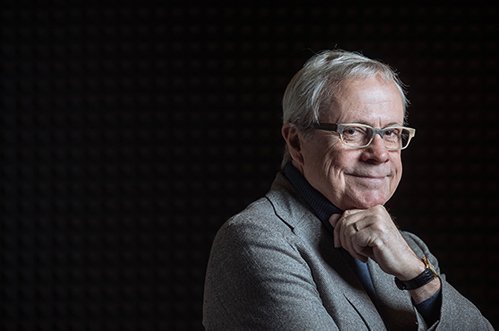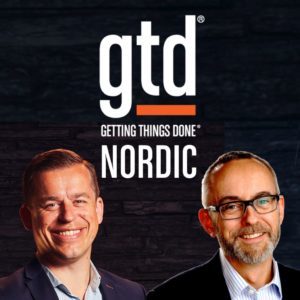David Allen's Blog, page 33
February 5, 2020
Is Your World Outrunning You?
There is nothing new in the world, except how frequently things are new, and the number of people having to accept and adapt consistently to that reality. The difference between your world and that of your parents is in how much less you can count on anything providing stability in your life and work, for […]
The post Is Your World Outrunning You? appeared first on Getting Things Done®.
January 9, 2020
F.D.’s GTD Story
Note: F.D.’s GTD story is in the form of an email he sent to David Allen. In it, he describes how he came across GTD, the positive impact it has had on his life, and the tools he uses. Hello David! I’d like to wish you, your family, and your team a Happy New Year. […]
The post F.D.’s GTD Story appeared first on Getting Things Done®.
January 7, 2020
Episode #56: David Allen on Mental RAM, Rapid Refocusing, and Checklists
Today we have three separate, rare segments pulled from the archives on different concepts that are all related to memory and performance improvement. First, you’ll hear a segment regarding the idea of mental RAM, and what happens when we leave unclosed loops open in our lives. Next, you’ll learn about multitasking vs. rapid refocusing and […]
The post Episode #56: David Allen on Mental RAM, Rapid Refocusing, and Checklists appeared first on Getting Things Done®.
November 22, 2019
Bob’s GTD Story
Note: Bob’s GTD story is in the form of an email he sent to the team at David Allen Company. In it, he describes how he came across GTD, what tools he has used, and the positive impact it has had on his life. Greetings! My name is Bob Mecozzi, and I have been the […]
The post Bob’s GTD Story appeared first on Getting Things Done®.
November 19, 2019
Episode #55: David Allen on Removing System Drag
What behaviors actually make a difference in your GTD system? Listen as David Allen shares tips on removing system drag in five critical areas. Subscribe or Download to GTD Podcasts iTunes Stitcher Libsyn Google Play Music Spotify SoundCloud
The post Episode #55: David Allen on Removing System Drag appeared first on Getting Things Done®.
October 30, 2019
Where’s the Kernel in the Creative Process?
If you’re like me, you might wish for a way to speed up the cycle of creativity, to accomplish something faster and with less uncertainty during the process. Unfortunately, I have not found that it works that way. But I have found that there are reliable actions you can take to keep the creative cycle moving forward, despite the times when you may not know what the final product will look like. My essay this month explores the success factors for getting to the “kernel” of any creative endeavor.
All my best,
The Creative Cycle
Recently a graphic artist was talking with me about his own creative process in coming up with designs for his clients. “At some point, I come up with the kernel. From there it all starts to piece together. Until then I’m a mess.” He got me thinking about “the kernel” — something I’ve experienced with every essay I’ve written, every purpose statement formulation I’ve facilitated, every new workflow configuration I’ve created with a client, and every real planning process I’ve been involved with.
The time and energy required for creating something goes through a cycle, one that is seldom as easy or as immediately evident and as clear as I would like to imagine it is. There is an initial framing — an impetus to create something, and a raw idea about how to express it. Then a step into the unknown. Then thinking. Then an expression of that thinking. Then a reflection upon that reflection. More thinking. Then pushing and pulling on pieces here and there. And nothing is quite working, quite yet, quite like I think it should. I get drowsy, looking for any excuse to do something else a lot easier. I question whether anything at all was valuable in the initial idea, or whether the process will really work (though it always has). I feel like I’ve fallen off the end of the some psychological pier, hanging on by a thread, wondering why I ever started down this path to begin with.
And somewhere, somehow, at some time, things start to make some sense. A key concept, supported by a set of ideas, starts to solidify. Everything starts to come together. Then there comes a point when I find myself over the crest, starting to coast downhill. I’m filling in the blanks, adding necessary detail, refining the expression until there is cohesion and completion of the work. “Aha!”s happen in and around the material.
This cycle is inherent in the thinking process of professional life, as well as more artistic expressions. A positive impetus pushes us into the frontier, we flounder in murky and unfamiliar territory, and at some point we reintegrate the experience into a new whole.
The Nature of the Creative ProcessI still don’t know much intellectually about the nature of that creative process. What is the underlying principle at work here? Why do we seem to have to work so hard to get the kernel? And my interest in productivity causes me to ask how I can get to it faster, easier, more effectively, with less mess and the frustrations that often accompany it.
Perhaps it is enough to just understand that it works this way. Soups need to simmer. I have learned that there is an inherent rhythm to things that often cannot be compressed into less space and time. Creative expressions and thinking endeavors need room, and the ability for less-than-conscious parts of our internal computers (and perhaps our spirit) to do their magic.
Smart PlaceholdersThat’s why it is very smart to put some placeholder for the project out on front of the mind as soon as it begins to emerge on the radar — on a whiteboard, on a “Projects” list, on a blank canvas or piece of paper. It’s also good to do some creative focusing on it before the deadline is too close. That focus may not feel like a completion yet, but it will stir the subliminal stew, which just takes time to mature appropriately. Too many times I’ve waited until the last minute to do the thinking I really needed to apply, which requires more time, energy, and patience than I allowed myself.
The two success factors in the process of finding the kernel seem contradictory. First, I need a strong intention. If I just sit at the computer wanting to write something, my brain can stay barren for a long time. I must have some juices flowing about expressing something or achieving a result. Secondly, I have to let it flow, without too much forcing or pushing on it. High anticipation with no expectation is the best approach for creating anything, and a nice way to go through life. I know I can still improve my own behaviors and habits that make that a lot easier to implement.
The shrewd guess, the fertile hypothesis, the courageous leap to a tentative conclusion — these are the most valuable coin of the thinker at work.
—Jerome S. Bruner
This essay appeared in David Allen’s Productive Living Newsletter. Subscribe for free here .
The post Where’s the Kernel in the Creative Process? appeared first on Getting Things Done®.
October 28, 2019
Episode #54: David Allen on Someday/Maybe and Incubation Best Practices
David Allen shares about the Someday/Maybe list, and best practices for incubating things for potential future action. He provides examples of what you might put on your Someday/May list, and specific circumstances in which you may find it helpful to incubate information for a later date.
In this segment, David mentions that there are instructions for setting up a “bring forward” or “tickler” file available on the website. Click here to get that PDF.
This podcast is an excerpt from the GTD Live audio program that has approximately 9-1/2 hours of content. You can use coupon code gtdlive for a 15% discount.
Subscribe or Download to GTD Podcasts
iTunes
Stitcher
Libsyn
Google Play Music
Spotify
SoundCloud
The post Episode #54: David Allen on Someday/Maybe and Incubation Best Practices appeared first on Getting Things Done®.
October 6, 2019
Episode #53: An Overview of GTD
This engaging and inspiring interview with David Allen, by Tragedy and Hope broadcasts, explores the key principles of GTD and how to make informed choices with ease. The interviewer, Richard Grove, is a GTD enthusiast himself, and his intelligent questions make this interview particularly interesting.
Subscribe or Download to GTD Podcasts
iTunes
Stitcher
Libsyn
Google Play Music
Spotify
SoundCloud
The post Episode #53: An Overview of GTD appeared first on Getting Things Done®.
August 27, 2019
Announcing a new English-language podcast from GTDnordic
We are delighted to announce that our partner GTDnordic has a new English-language podcast. In the beginning episodes, you will get to hear Morten Rovik and Lars Rothschild Henriksen talk about the 5 Steps of GTD workflow. If you’re new to GTD, it’s an excellent place to start. And if you’re more experienced, it’s a timely refresher.
The post Announcing a new English-language podcast from GTDnordic appeared first on Getting Things Done®.
August 23, 2019
Episode #52: The Ultimate GTD App – Part Two
At the June 2019 GTD Summit, David Allen briefly shared a vision of the ultimate GTD app, which consists of 19 pages of hand-drawn drafts of the screens he would want to use. To expand on that topic, we recorded David talking with Eric Mack and John Forrister about the past, present, and future of GTD software. It’s a wide-ranging discussion with stories that will inform, entertain, and maybe even surprise you. This episode is part two of two. If you have not heard part one yet, that’s the place to start.
Subscribe or Download to GTD Podcasts
iTunes
Stitcher
Libsyn
Google Play Music
Spotify
SoundCloud
The post Episode #52: The Ultimate GTD App – Part Two appeared first on Getting Things Done®.
David Allen's Blog
- David Allen's profile
- 1484 followers






